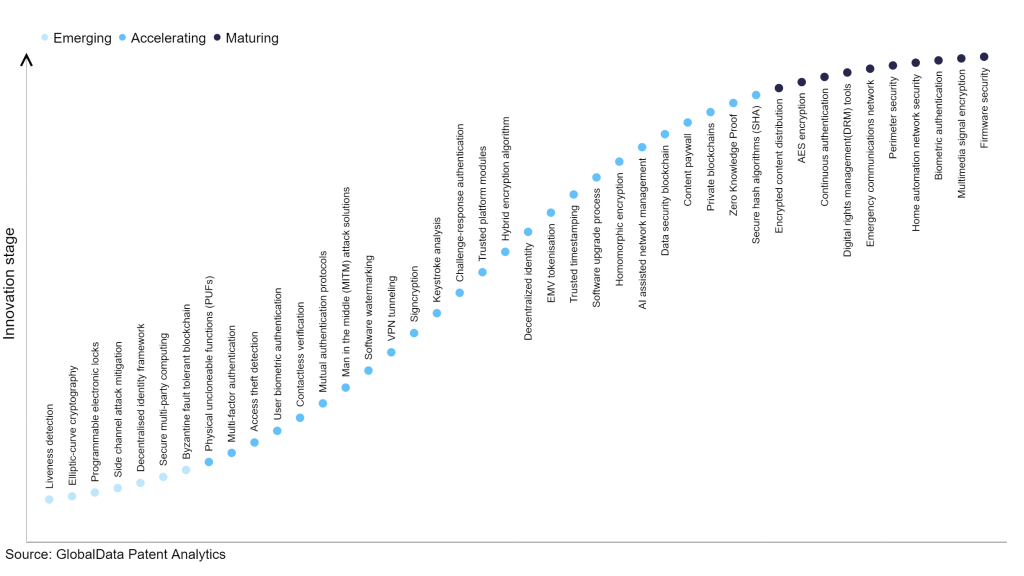The technology industry continues to be a hotbed of innovation, with activity driven by the emergence and accelerated adoption of disruptive technologies such as artificial intelligence (AI), internet of things (IoT) and mobility, and digital service models, as well as growing importance of technologies such as next-generation firewalls (NGFW), security information and event management (SIEM), and intrusion detection system (IDS). While use of these technologies has enabled the enterprises to digitally transform their operations, it has also opened several threats in the form of security breaches and unauthorised access to data, which has been driving focus on cybersecurity. In the last three years alone, there have been over 3.6 million patents filed and granted in the technology industry, according to GlobalData’s report on Innovation in Cybersecurity: AI-assisted network management. Buy the report here.
However, not all innovations are equal and nor do they follow a constant upward trend. Instead, their evolution takes the form of an S-shaped curve that reflects their typical lifecycle from early emergence to accelerating adoption, before finally stabilising and reaching maturity.
Identifying where a particular innovation is on this journey, especially those that are in the emerging and accelerating stages, is essential for understanding their current level of adoption and the likely future trajectory and impact they will have.
300+ innovations will shape the technology industry
According to GlobalData’s Technology Foresights, which plots the S-curve for the technology industry using innovation intensity models built on over 2.5 million patents, there are 300+ innovation areas that will shape the future of the industry.
Within the emerging innovation stage, byzantine fault tolerant blockchain, secure multi-party computing, and decentralized identity framework are disruptive technologies that are in the early stages of application and should be tracked closely. Secure hash algorithms (SHA), zero knowledge proof and private blockchains are some of the accelerating innovation areas, where adoption has been steadily increasing. Among maturing innovation areas are firmware security, multimedia signal encryption and biometric authentication, which are now well established in the industry.
Innovation S-curve for cybersecurity in the technology industry

AI-assisted network management is a key innovation area in cybersecurity
AI-assisted network management in cybersecurity refers to the use of artificial intelligence technology to monitor, analyse, and manage network security operations. It involves using machine learning algorithms, deep learning techniques, and other AI technologies to automate and optimise network security processes.
AI-assisted network management in cybersecurity can help security professionals to detect and respond to security threats more quickly and accurately, as well as identify potential security vulnerabilities before they can be exploited. The technology can also help to reduce the workload on security teams, as many routine security tasks can be automated using AI.
GlobalData’s analysis also uncovers the companies at the forefront of each innovation area and assesses the potential reach and impact of their patenting activity across different applications and geographies. According to GlobalData, there are 240+ companies, spanning technology vendors, established technology companies, and up-and-coming start-ups engaged in the development and application of AI-assisted network management.
Key players in AI-assisted network management – a disruptive innovation in the technology industry
‘Application diversity’ measures the number of different applications identified for each relevant patent and broadly splits companies into either ‘niche’ or ‘diversified’ innovators.
‘Geographic reach’ refers to the number of different countries each relevant patent is registered in and reflects the breadth of geographic application intended, ranging from ‘global’ to ‘local’.
Patent volumes related to AI-assisted network management
Source: GlobalData Patent Analytics
Cisco is the leading patent filer in AI-assisted network management. The company’s patents are aimed at improving network management solutions by employing latest technologies and ensuring cybersecurity.
Other prominent innovators in the space include Huawei and International Business Machines (IBM).
By geographic reach, Ipanema Technologies, Permutive and Emerson Electric are some of the top companies. In terms of application diversity, Ayyeka Technologies, AO Kaspersky Lab and Amazon.com are some of the leading innovators.
AI-assisted network management has become an increasingly important component of cybersecurity in recent years. With the rise of sophisticated cyber threats, it provides real-time threat detection and response capabilities that can help organisations quickly detect and respond to potential threats.
To further understand how cybersecurity is disrupting the technology industry, access GlobalData’s latest thematic research report on Cybersecurity – Thematic Research.
Data Insights
From

The gold standard of business intelligence.
Blending expert knowledge with cutting-edge technology, GlobalData’s unrivalled proprietary data will enable you to decode what’s happening in your market. You can make better informed decisions and gain a future-proof advantage over your competitors.







